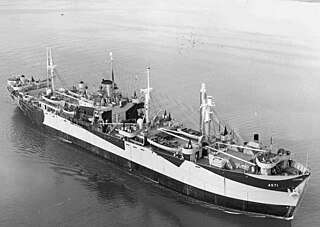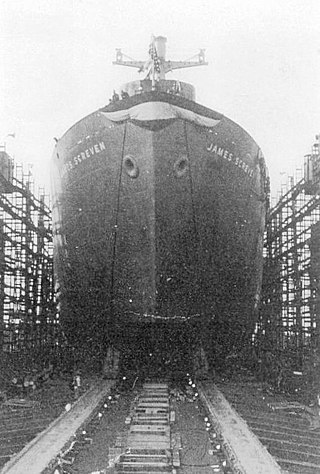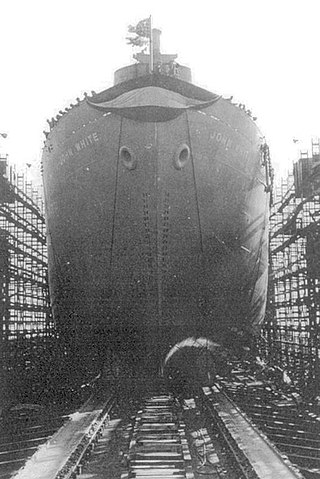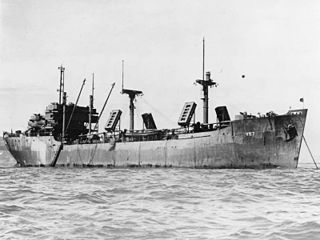USS Nanticoke (AOG-66), was a type T1 Klickitat-class gasoline tanker built for the US Navy during World War II. She was named after the Nanticoke River, in Delaware and Maryland.

USS Cetus (AK-77) was a Crater-class cargo ship in the service of the US Navy in World War II. Named after the equatorial constellation Cetus, it was the only ship of the Navy to bear this name.

USS Baham (AK-122/AG-71) was a Basilan-class auxiliary ship, converted from a Liberty ship, commissioned by the United States Navy for service in World War II. She was first named after former Florida resident Elizabeth C. Bellamy, the daughter of General William Croom, and wife of Doctor Samuel C. Bellamy. She was renamed and commissioned after Baham, a star in constellation Pegasus. She was responsible for delivering troops, goods and equipment to locations in the war zone.

USS Draco (AK-79) was a Crater-class cargo ship commissioned by the US Navy for service in World War II. Named after the constellation Draco. She was responsible for delivering goods and equipment to locations in the war zone.

USS Sculptor (AK-103) was a Crater-class cargo ship commissioned by the US Navy for service in World War II. Sculptor was named after the constellation Sculptor. She was responsible for delivering troops, goods and equipment to locations in the Asiatic-Pacific Theater.
USS Alkaid (AK-114) was a Crater-class cargo ship, converted from a Liberty Ship, commissioned by the US Navy for service in World War II. She was first named after William G. Sumner, a classical liberal American social scientist. She was renamed and commissioned after Alkaid, a star in the Big Dipper asterism or constellation Ursa Major. She was responsible for delivering troops, goods and equipment to locations in the war zone.

USS Crux (AK-115) was a Crater-class cargo ship, converted from a Liberty Ship, commissioned by the US Navy for service in World War II. She was first named after Peter Stuyvesant, a Dutch politician that served as the last Dutch director-general of the colony of New Netherland from 1647 until it was ceded provisionally to the English in 1664. She was renamed and commissioned after Crux, a constellation centered on four stars in the southern sky in a bright portion of the Milky Way. She was responsible for delivering troops, goods and equipment to locations in the war zone.

USS Shaula (AK-118) was a Crater-class cargo ship, converted from a Liberty Ship, commissioned by the US Navy for service in World War II. She was first named after James Screven, an American general during the American Revolutionary War. She was renamed and commissioned after Shaula, the second-brightest star system in the constellation of Scorpius. She was responsible for delivering troops, goods and equipment to locations in the war zone.

USS Matar (AK-119) was a Crater-class cargo ship, converted from a Liberty Ship, commissioned by the US Navy for service in World War II. She was first named after Napoleon B. Broward, an American river pilot, captain, and politician; he was elected as the 19th Governor of the US state of Florida. She was renamed and commissioned after Matar, a binary star in the constellation of Pegasus. She was responsible for delivering troops, goods and equipment to locations in the war zone.

USS Menkar (AK-123) was a Crater-class cargo ship, converted from a Liberty Ship, commissioned by the U.S. Navy for service in World War II. She was first named after John White, a settler among those who sailed with Richard Grenville, to present-day North Carolina, in 1585, to found the Roanoke Colony. White acted as artist and mapmaker to the expedition. He became the governor, in 1587, of the colony, and his granddaughter, Virginia Dare, was the first English child born in the Americas. She was renamed and commissioned after Menkar, the second-brightest star in the constellation of Cetus. She was responsible for delivering troops, goods and equipment to locations in the war zone.
USS Propus (AK-132) was a Crater-class cargo ship, converted from a Liberty Ship, commissioned by the US Navy for service in World War II. She was first named after Frederick Tresca, a French-born lighthouse keeper, sea captain, pioneer shipping man, and Union blockade runner in Florida. She was renamed and commissioned after Propus, a star in the constellation Gemini. She was responsible for delivering troops, goods and equipment to locations in the war zone.

USS Ara (AK-136) was a Crater-class cargo ship commissioned by the US Navy for service in World War II. Ara is named after the constellation Ara. She was responsible for delivering troops, goods and equipment to locations in the Asiatic-Pacific Theater.

USS Pontotoc (AK-206/AG-94/AVS-7) was an Alamosa-class cargo ship acquired by the US Navy shortly before the end of World War II. She was converted into a Gwinnett-class aviation stores issue ship to carry aviation parts and spares, and to issue them to the US Pacific Fleet and activities as needed.
USS Muskingum (AK-198/T-AK-198) was an Alamosa-class cargo ship that was constructed for the US Navy under a US Maritime Commission (MARCOM) contract during the closing period of World War II. She supported the end-of-war Navy effort. On 7 March 1946 Muskingum was placed in service under bareboat charter with the US Army under the Shipping Control Authority for the Japanese Merchant Marine with a Japanese crew. In 1950, she was reactivated and placed into service with the Military Sea Transportation Service as USNS Muskingum (T-AK-198) until being struck from the Navy list in 1973. She was ultimately transferred to the Trust Territory of the Pacific Islands (TTPI) and the Republic of Palau.
USS Pemiscot (AK-201) was an Alamosa-class cargo ship that was constructed for the US Navy during the closing period of World War II. By the time she was scheduled for commissioning, the war's end caused her to be declared “excess to needs” and she was returned to the US Government and struck by the Navy.
USS Rockdale (AK-208) was an Alamosa-class cargo ship that was constructed for the US Navy during the closing period of World War II. She served with distinction in the Pacific Ocean theatre of operations and returned home in 1946 to be placed into the "mothball" fleet and sold in 1947.
USS Sebastian (AK-211) was an Alamosa-class cargo ship that was constructed for the US Navy during the closing period of World War II. She was retained by the Navy for only a short period of service before being inactivated as "excess to needs."

USS Klickitat (AOG-64), was the lead ship of the type T1 Klickitat-class gasoline tanker built for the US Navy during World War II. She was named after the Klickitat River, in Washington.
USS Michigamme (AOG-64), was a type T1 Klickitat-class gasoline tanker built for the US Navy during World War II. She was named after the Michigamme River, in Michigan.

USS Peconic (AOG-68), was a type T1 Klickitat-class gasoline tanker built for the US Navy during World War II. She was named after the Peconic River, in New York.












